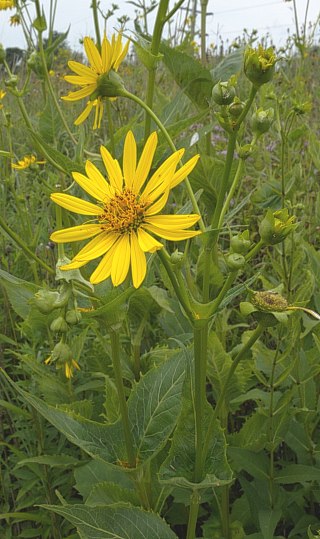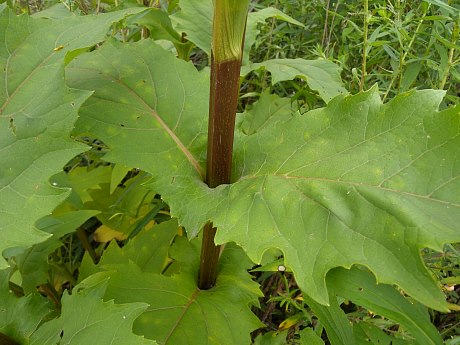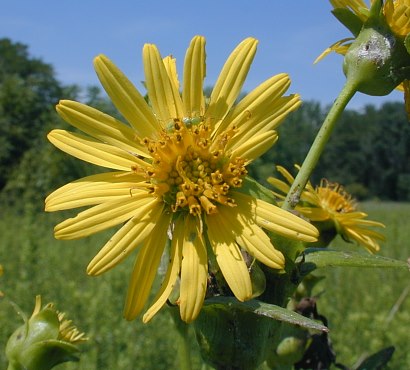Description: This perennial plant is about 4-10' tall and remains unbranched, except for the panicle of flowering stems near the apex. The central stem is thick, hairless, and four-sided. The large opposite leaves are up to 8" long and 5" across, which join together around the central stem to form a cup that can hold water, hence the name of the plant. These leaves are broadly lanceolate to cordate, coarsely toothed, and have a rough, sandpapery texture. The yellow composite flowers bloom during early to mid-summer for about 1-1½ months. Each sunflower-like composite flower is about 3-4" across, consisting of numerous yellow disk florets that are surrounded by 18-40 yellow or pale yellow ray florets. The infertile disk florets protrude somewhat from the center and are rather conspicuous, while the ray florets are fertile. The latter produce thin achenes, each with a well-developed marginal wing, which are dispersed to some extent by the wind. The root system consists of a central taproot, and abundant shallow rhizomes that help to spread the plant vegetatively, often forming substantial colonies.

Cultivation:
The preference is full or partial sun, and moist loamy soil. This plant
may drop some of its lower leaves in response to a drought. Sometimes,
the leaves and buds of distressed plants turn brown, growth becomes
stunted, and blossums abort in response to disease or drought. Another
problem is that Cup Plant may topple over during a rainstorm with
strong winds, particularly while it is blooming, or situated on a slope.
Range & Habitat:
The native Cup Plant occurs throughout Illinois, except for a few
southern
counties (see Distribution
Map). It is fairly common. Typical habitats include moist
black soil prairies, moist meadows near rivers, low-lying woodland
edges and thickets, fens and seeps, lake borders, fence rows, and along
ditches near railroads.

Faunal Associations: Long-tongued bees, butterflies, and skippers are common visitors and the most important pollinators of the flowers. Some short-tongued bees, wasps, bee flies, and other kinds of flies also visit the flowers for pollen or nectar. The larvae of an Antistrophus sp. (Gall Wasp sp.) feed within the stems of this plant, and may attract the hyperparasitic wasp Eurytoma lutea. Various birds, especially goldfinches, are very fond of the seeds, and drink water from the cups formed by the leaves. Because of the tendency to form dense colonies, this plant provides good cover for birds, which often lurk among the leaves during the heat of the day, searching for insects or pausing to rest. Large herbivores, especially cattle, may eat the eat leaves of Cup Plant, especially those of immature plants.

Photographic
Location:
The photographs of the flowering plants and perfoliate leaves were
taken at a small restored prairie in Urbana, Illinois, while the
photograph of the flowerhead close-up was taken at Meadowbrook Park in
Urbana, Illinois.
Comments:
This is an
imposing, but attractive plant when it is in bloom. Cup Plant is easy
to distinguish from other Silphium spp., as well as
various sunflowers, by the perfoliate leaves that can hold water, and
the hairless four-angled stems.